Paris is a city for walking – for tourists, for flâneurs, and also for pilgrims. For some, it is the conclusion of a pilgrimage. On the rue du Bac, you will see pilgrims from many countries entering the courtyard of the Chapel of Our Lady of the Miraculous Medal. The Basilica of Sacré-Coeur is another destination for pilgrims.
For others, Paris can be the start of the Camino de Santiago, although only a small minority of those attempting the Camino start here nowadays. The route, known as the Via Turonensis, begins at the Tour St-Jacques in the centre of Paris…
…and leads through Orléans, Tours, Poitiers, and Bordeaux to the border with Spain.
It was a busy route in the Middle Ages, but today’s pilgrims (I’ve seen a few online accounts by some hardy souls) usually find it long and solitary, with the old ways overgrown or replaced by busy highways and a shortage of inexpensive overnight lodgings. It is not for the faint of heart.
But lots of people could manage the first part of the journey, setting out from the Tour St-Jacques and walking to the edge of the city, a distance of less than 5 kilometres, much of it along an old Roman way, through interesting neighbourhoods and past historic sites. Norman and I know much of the route by heart, because we have frequently rented an apartment on this route. So I thought I would walk it in my imagination with you, in anticipation of our next visit.
Join me at the Tour St-Jacques. During our early visits to Paris, this tower, the only remaining feature of the long-lost church St-Jacques de la Boucherie, was swathed in scaffolding and tarpaulins. It finally re-emerged in 2009. We’ve never been to the top, but we’ve often gazed at it as we wait for the No. 38 bus which stops on the Avenue Victoria in front.
Take the rue St-Martin towards the river and cross the Seine to the Ile de la Cité by the Pont Notre-Dame (once known as the Grand Pont). Continue to the Left Bank by the Petit Pont. Both bridges date from the 19th century, but there has been a river crossing here at the island since Paris was called Lutetia.
At first, the road south is called rue du Petit Pont. This is what it looked like when Eugene Atget photographed it in 1906. Note the Vespasienne on the left, a superior model with a lamp on top.

The year after Atget took this photo, this road was enlarged and the buildings on the left, which formed part of the hospital complex of the Hotel Dieu, were removed (along with the Vespasienne). Today there is a park where they once stood. But several buildings on the right are recognizable from the older photo.

The rue du Petit-Pont continues for a couple of blocks, and then becomes the rue St-Jacques. The street has had many names over the years, but it derived its current name indirectly from the pilgrimage route. It was once a Roman road called the Via Superior, and then became the Grande Rue du Petit Pont in the 12th century. In the 13th century, an order of Dominican monks opened a hospice for pilgrims not far from where the Panthéon is now, named for St-Jacques (because that’s where the pilgrims were going). Several centuries after that, the street took the name St-Jacques.
Where the street changes its name, you will see the back of the church of St-Severin. It is named for a hermit who lived on or near this spot in the 5th century (his saint’s day is November 27). It may seem odd to live the life of a hermit in the middle of a city, rather than out in the desert, but cities have one big advantage – passersby who give alms or food to the walled-up hermit (there was always a window to allow for these donations). In return, the hermit offered prayers for the passersby.
Severin was far from the only one to wall himself up this way. There was a long tradition of recluses in Paris, living a solitary life in tiny reclusoirs, many if not most of them women (in English they were known as anchorites or anchoresses). Some lived in cells adjoining a church so they could be part of the services; others lived in tiny structures on bridges or even in cemeteries.
Here is an etching of St-Severin looking west from the rue St-Jacques by Caroline Armington.
At the corner with the rue de la Parcheminerie (the street of the parchment makers) is a stripy brick building, an elementary school. Paris schools always seem to be built in brick, rather than stone. There is probably a reason for that. It certainly makes them easy to recognize.
At the next intersection is the boulevard St-Germain. An impressive building with a dome on the far corner includes a shop on the ground floor selling bandes-dessinés – hardcover, full-colour, graphic novels of adventure and action. Very French.
At the intersection with the rue du Sommerard, you may see a bookshop on the south side of the cross street on the right. It used to be called Pippa (the same as my family nickname), but now goes by La Librairie des Editeurs Indépendants. I hope it survived the pandemic. This is a picture we took in the winter of 2010.
At the end of the rue du Sommerard, you can see the back of the Musée Cluny.
I am quite sure that Au Vieux Campeur on the corner has survived the pandemic. The store for all things outdoorsy is spread over half a dozen or more premises in this area. We have bought everything from clothing to a mosquito net (long story) in various branches of the store.
Carry on and you will be deep in academic territory. At the corner of the rue des Ecoles on the left is the Collège de France. This is not a teaching institution, but a research establishment filled with laboratories and libraries, although faculty members do give public lectures from time to time. Many Nobel prize winners have worked here. This image from our postcard collection shows a bronze statue of a thoughtful physiologist Claude Bernard. That statue was melted down during the Second World War, and replaced with a stone statue in a different pose after the war.
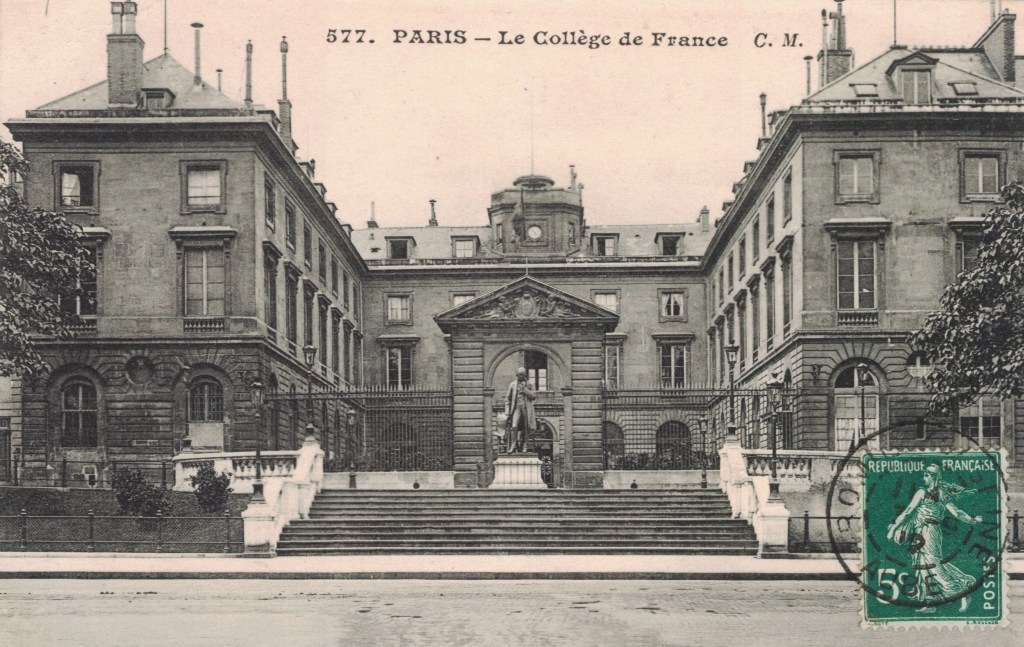
As you continue south, on the right side is the back of the Sorbonne, crowned by a tall observatory tower with a clock. I once sat on uncomfortable benches in the Sorbonne to listen to really good lectures. I remember emerging from a lecture on symbolism in 19th-century literature so distracted by my thoughts that I was nearly run over by a car in the parking lot. Opposite the Sorbonne, on the left side of rue St-Jacques is the Lycée Louis Le Grand, known for its illustrious alumni, from Victor Hugo to Edgar Degas to André Citroen. It’s an imposing building, too much to take in, but Norman once captured a photo of one of the chimneys with the school monogram in the setting sun.

The next block has the law faculty on the left and then you emerge into the rue Soufflot with the Panthéon to your left and a view of the Jardin du Luxembourg and even the Eiffel Tower in the distance on the right. On June 22 past, there was a special event at the Panthéon for the 70th anniversary of the burial of Louis Braille there and the 170th anniversary of his death. It was preceded by a short conference at the Institut National des Jeunes Aveugles, and yours truly contributed a brief recorded talk on Louis Braille and Charles Barbier. I was hugely chuffed to be included.
The next few blocks are filled with eateries and shops, including one of our favourite restaurants, Au Port de Salut (many happy memories). As the road approaches the rue Gay-Lussac, you will see two university institutes: geography and oceanography. Here is geography.
I remember the first time we went past. What a contrast with the department of geography at the University of Toronto, which is housed on one floor of a 1960s-era building. Sigh.
Oceanography, also called the Maison de l’Océan, has a tower and a bronze octopus above the doorway.
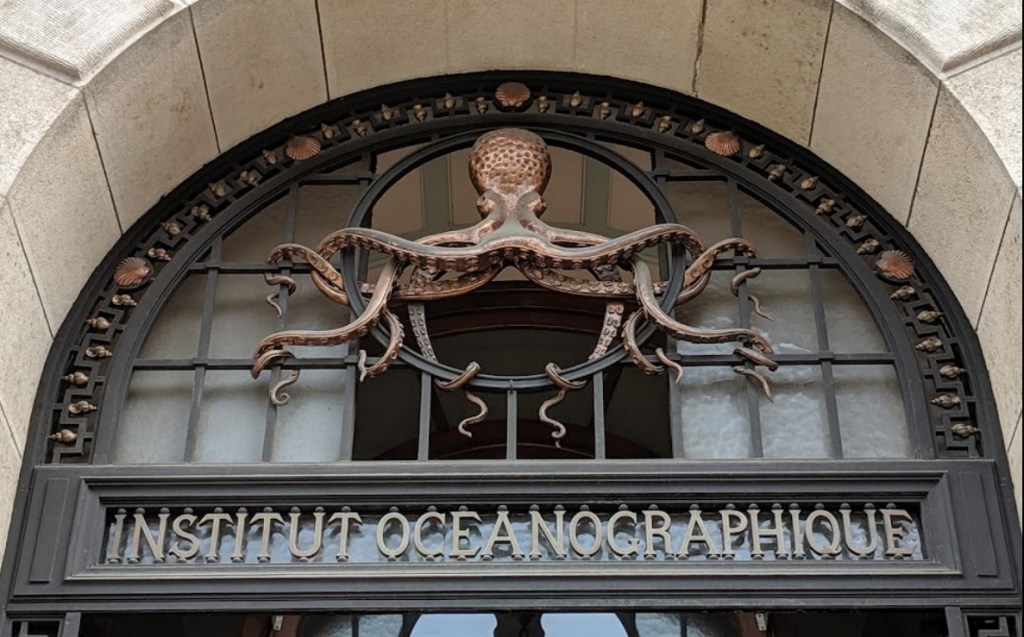
Inside are murals of sailing ships in its lecture hall, although the low-backed benches, despite the padding, don’t look much more comfortable than those at the Sorbonne.

Another clock tower looms up on the right, the church of St-Jacques des Haut Pas. Another link to St-Jacques. “Haut Pas” refers to the location in Italy (Altopascio or High Pass) where the monks who first settled here in the 12th century came from. The photograph below, taken by Norman, is from the south, so the tower appears on the left.
In the 18th century, the parish priest was Jean-Denis Cochin, who founded a hospital for poor workers, many of whom were injured working in quarries. That foundation went on to become the vast Hôpital Cochin, a general hospital, which lies farther up the road.
The next street is named for the Abbé de l’Epée, another benefactor of those in need. On the far side of the intersection, on the right, is the school he founded, the Institut National des Jeunes Sourds, a school for students who are deaf. It has a huge formal garden, hidden behind a wall. The Abbé de l’Epée noticed that when students arrived from various parts of France, they already used their own diverse forms of sign language. He observed them and developed a common language for use at the school. The Abbé was honoured in 2018 with his own Google Doodle (now that’s fame).
The road bends to the left as it passes the school, and continues past some modern apartment blocks and crosses the rue des Feuillantines. As you cross the street, look left and where you see a tree sticking out, that is the childhood home (or rather, one of the childhood homes) of Victor Hugo. That massive block in the distance is a modern lycée.

The road bends again, this time to the right, and passes the Schola Cantorum, a private music conservatory established in a former convent. The conservatory specializes in early music, in particular the singing of Gregorian chant, Renaissance polyphony, and Baroque music. One of its students was Joseph Canteloube, who collected and arranged folksongs from the Auvergne. My CD of those songs (the singer is Kiri Te Kanawa) gets a lot of use; when you listen, you are transported to the clear air of the hill country.
The street widens out into a square in front of the Val de Grace. We have written about this beautiful space before and I never cease to be amazed at how few people visit it. On our last visit, in January 2020, I took this picture of it from the boulevard the night before we flew home, never thinking how long it would be before we returned.

By this point, as we are nearing our rented apartment, we are into the home stretch. Past our favourite crêperie (Pomme d’Amour), the offices of the Parti Socialiste, the antique shop that is almost never open, Picard (great ice cream), the Carrefour Express and the convenience store opposite (for when we run out of something essential), the butcher, the baker (both excellent), and out onto the Boulevard Port-Royal.
A friend calls this the Carrefour de la Mort, partly because there are so many funeral parlours in the area and partly because the traffic is confusing (two lanes of east-west traffic for cars followed by two lanes going east and west for buses and bicycles). We have also written about this place before.
I see I have gone on long enough for now, so I will conclude this tour next time.
Text by Philippa Campsie, photographs by Norman Ball and Philippa Campsie, Atget photograph from Gallica, additional images from Wikimedia Commons and Google Street View.


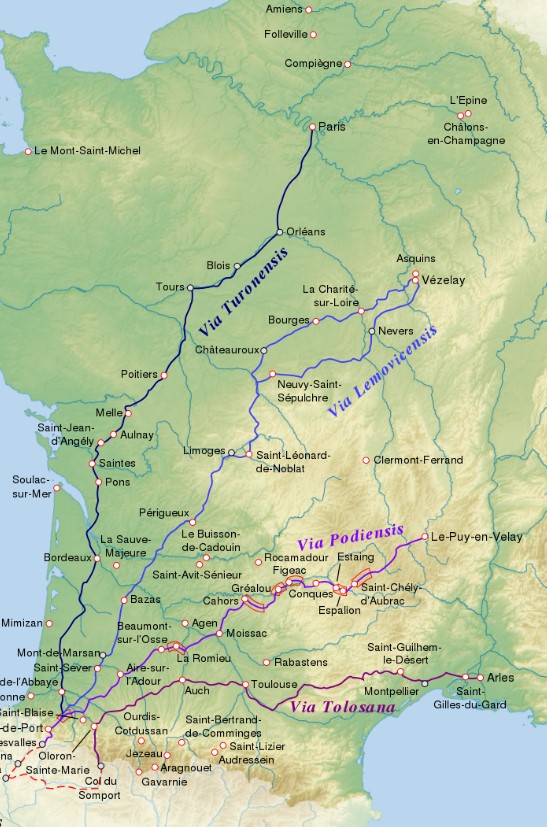
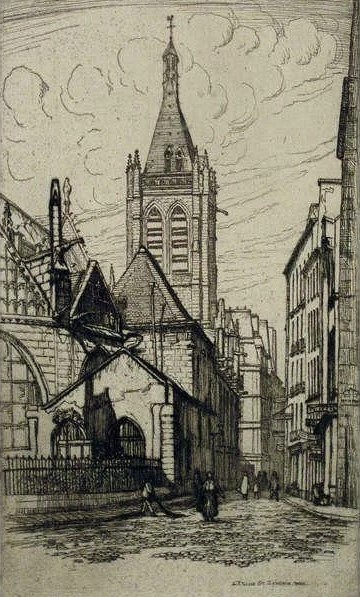
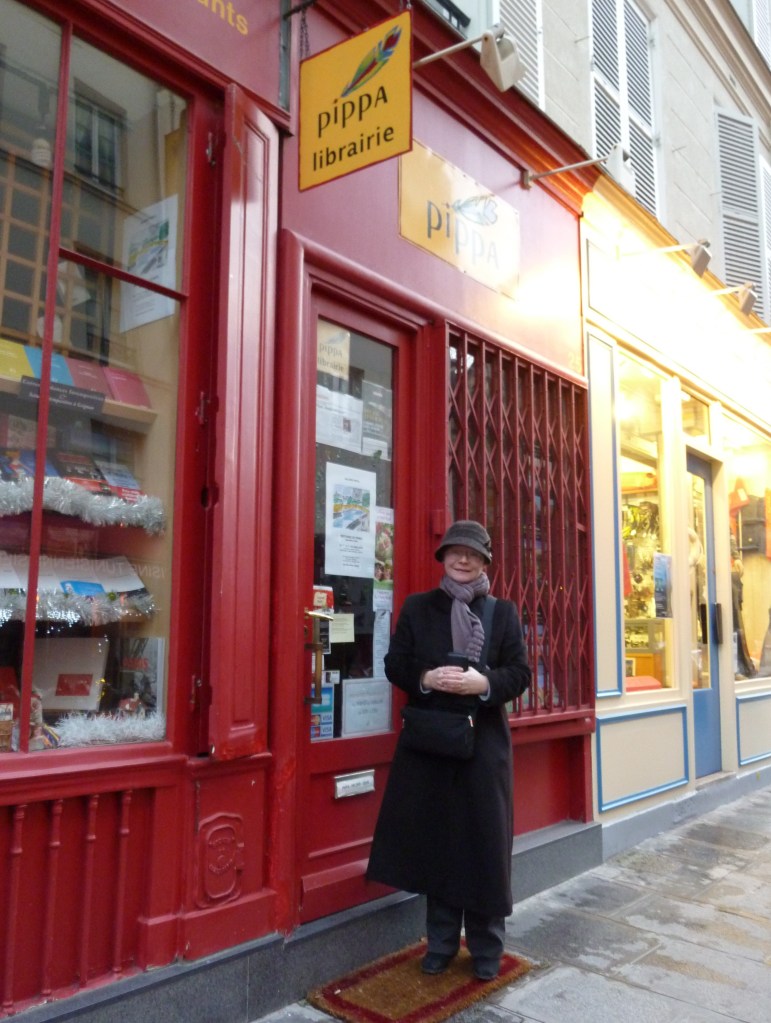

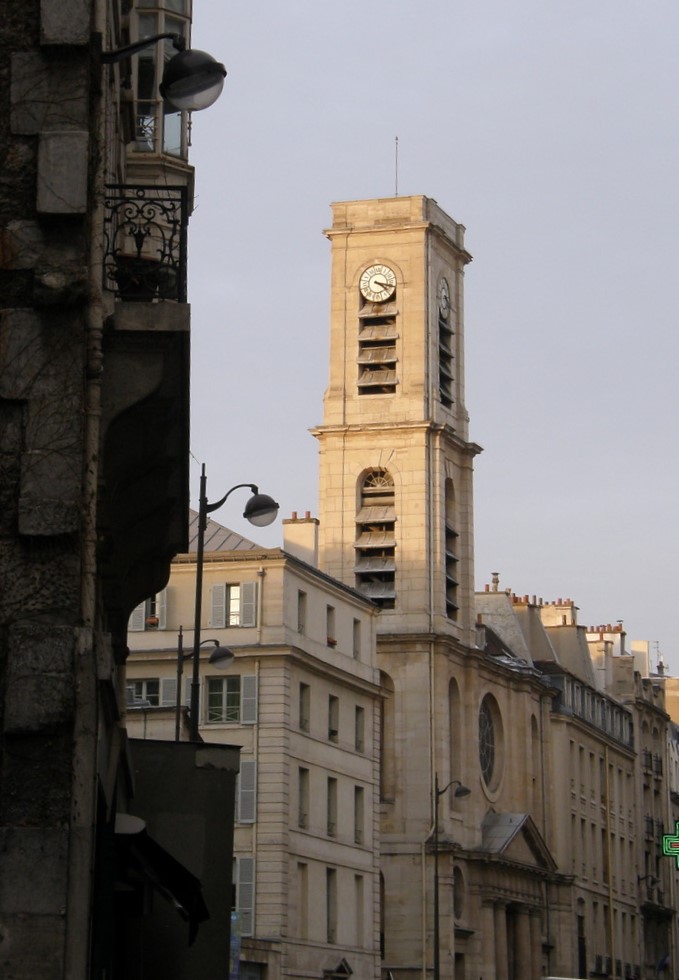


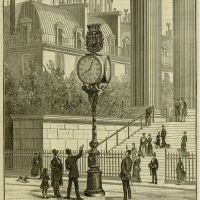

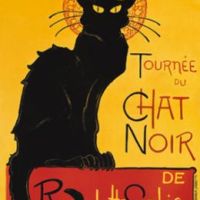
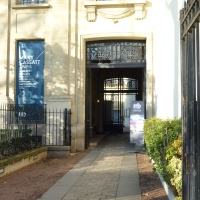














I live near part of the Via Turonensis, south of Tours. It is quite well marked in this area but we don’t get many pilgrims.
That would be a lovely area for walkers of any kind.
I know this area fairly well but I always discover interesting new things from your writings. Thanks so much!
I always discover new things when I write, too!
Kiri is wonderful in the Songs of the Auvergne, but really special is Natania Davrath in the complete songs. (I read your postings with great interest but with increasing envy. In addition to its being unclear when we will get back to Paris, I’m not sure that I’ll be able to do much in the way of walking. And the Paris Camino looks particularly interesting. Ah, well.) David HawkinsBrooklyn NY
I shall have to listen to Natania Davrath. I’ve been listening to Kiri since the 1980s. One does get set in one’s ways!
It is good to be back on the distribution list. I enjoyed the walk from Tour St. Jacques. Thank you so much. Hope you both had a great spring. enjoy summer. Dawn Monroe
All the best to you as well. Have a good summer.
Fascinating as always! Fabiano and I have been interested in doing the Camino for about 10 years but I’m not sure it’s possible. Perhaps this little piece of it would be fun instead.
Love, love, love the sign at the school of Oceanography. I would love something similar hanging over my own front door!
Never say never. It may yet happen. In some form. In a way you might not expect. But if you want to do it, you will.
We do not travel, but I love going along with you on your tours!! Thank you so much!!
God bless, C-Marie
Thank you. Actually, armchair travel makes the most sense these days, what with chaos at airports and Covid still a possibility!
Nice read
Your post brought back memories of my walk along that route starting at Tour Saint-Jacques in 2018, but your details of the surroundings on this early stage of “el camino” are enlightening. In September of ‘21, I finally timed my visit to Paris right, climbed the Tower’s 300-odd steps and enjoyed the tour given by the two knowledgeable young guides and the view from the top. I think it offers one of the better vistas of Paris, really. I hope you make it up there one of these days!
I hope so too. I can imagine that the view is spectacular.
Interesting tour, with some very nice photographs!
Glad you enjoyed it. Hope all is well with you.
Pingback: Paris Camino, part two | Parisian Fields
Good evening.
I intend to walk the pilgrimage route, starting in Paris. Are there any markings along the way that you know of, or any resources, maps, or books that will be helpful for my journey?
Hello Chris, Goyo seems to have answered your questions better than I could. My main advice for anyone walking in Paris (or anywhere really), is to keep your mobile phone tucked away, keep your eyes open, and look around. Do your preparation ahead of time so that when you get there, you can enjoy being there. I hope you have a wonderful camino.
That will be quite a journey! A year before Covid struck, I walked from the the Tour Saint-Jacques along rue Saint-Jacques/rue du Faubourg Saint-Jacques/rue de la Tombe Issoire and saw only two markings indicating that I was on the Camino: one blue and yellow painted scallop shell and some copper-colored iron protective door bars with scallop shells in the design, not really your typical Camino marking but it was cool looking and kept me walking to see if there were more indications along the way. As for resources, give caminoforum.com a look-see. It’s run by a guy named Ivar who’s based in Santiago de Compostela and it is a wealth of information about everything to do with the Camino, including question and answer forums, guidebooks and the like. You might want to check YouTube also, as there are a lot of vids that give info on times to walk, weather, equipment, mental and physical prep, etc. There are many Camino routes, so the more you know the better prepared you’ll be. ¡Buen camino!
I recently re-subscribed to Parisian Fields. Today I received an email asking me to confirm my email which I did. However, a page appeared which said there was a glitch and to try again. Same result. I went thru the subscribe process again and again, and got the same result. Any suggestions?